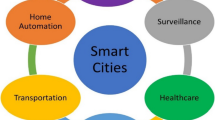Abstract
In developing countries, owing to a lack of adequate pedestrian facilities and insufficient traffic regulation, pedestrians tend to illegally cross at the midblock section to reach their destination. In developed countries, sidewalks and crosswalks are provided along with other pedestrian facilities, however, in developing countries, these facilities are either non-existent or poorly designed to cater to all age and gender groups. As such, pedestrians are forced to cross illegally at midblock sections in absence of these facilities. During these events, they compel the incoming vehicles to either alter their path or reduce their speed, thereby delaying the traffic. The paper’s aim is to quantify the delay experienced by various categories of vehicles. The research presents an exponential equation for the delay in presence of illegally crossing pedestrians. This research also seeks to define the Level of Service (LOS) on the basis of delay and volume to capacity (V/C) ratio. In this study, three urban midblock sections were chosen in Srinagar City. Further, K-means cluster analysis is then carried out to cluster the data for delay and V/C ratio. Level of Service (LOS) is thus, well-grounded on delay and V/C ratio and the same has been related to the values suggested by Indo-HCM, 2017. The findings of this study will be helpful in better understanding vehicular delay and categorizing the roads on basis of the delay that vehicles experience on that particular road, especially in mixed traffic conditions.








Similar content being viewed by others
Availability of data and material
Not applicable.
Code availability
Not applicable.
References
Oxley J, Fildes B, Ihsen E et al (1997) Differences in traffic judgements between young and old adult pedestrians 1. Accid Anal Prev 29:839–847. https://doi.org/10.1016/S0001-4575(97)00053-5
Bonneson JA (1998) Delay to major-street through vehicles due to right-turn activity. Transp Res Part A Policy Pract 32:139–148. https://doi.org/10.1016/S0965-8564(97)00028-1
Connelly ML, Conaglen HM, Parsonson BS, Isler RB (1998) Child pedestrians’ crossing gap thresholds. Accid Anal Prev 30:443–453. https://doi.org/10.1016/S0001-4575(97)00109-7
Khan FM, Jawaid M, Chotani H, Luby S (1999) Pedestrian environment and behavior in Karachi, Pakistan. Accid Anal Prev 31:335–339. https://doi.org/10.1016/S0001-4575(98)00075-X
Brewer MA, Fitzpatrick K, Whitacre JA, Lord D (2006) Exploration of pedestrian gap-acceptance behavior at selected locations. Transp Res Rec J Transp Res Board 1982:132–140. https://doi.org/10.1177/0361198106198200117
Kruszyna M, Mackiewicz P, Szydlo A (2006) Influence of pedestrians entry process on pedestrian delays at signal-controlled crosswalks. J Transp Eng 132:855–861. https://doi.org/10.1061/(ASCE)0733-947X(2006)132:11(855)
Holland C, Hill R (2007) The effect of age, gender and driver status on pedestrians’ intentions to cross the road in risky situations. Accid Anal Prev 39:224–237. https://doi.org/10.1016/j.aap.2006.07.003
Shi J, Chen Y, Ren F, Rong J (2007) Research on Pedestrian behavior and traffic characteristics at unsignalized midblock crosswalk: case study in Beijing. Transp Res Rec. https://doi.org/10.3141/2038-04
Lobjois R, Cavallo V (2007) Age-related differences in street-crossing decisions: the effects of vehicle speed and time constraints on gap selection in an estimation task. Accid Anal Prev 39:934–943. https://doi.org/10.1016/j.aap.2006.12.013
Mayeux A, Lovreglio R, Saleh W, Fonzone A (2015) Illegal pedestrian crossing at signalised junctions in urban areas: The impact of spatial factors. TRB 94th Annu Meet Washingt. https://doi.org/10.13140/2.1.1534.7520
Raghuram Kadali B, Perumal V (2012) Pedestrians’ gap acceptance behavior at mid block location. Int J Eng Technol 4:158–161. https://doi.org/10.7763/ijet.2012.v4.339
Yannis G, Papadimitriou E, Theofilatos A (2013) Pedestrian gap acceptance for mid-block street crossing. Transp Plan Technol 36:450–462. https://doi.org/10.1080/03081060.2013.818274
Raghuram Kadali B, Rathi N, Perumal V (2014) Evaluation of pedestrian mid-block road crossing behaviour using artificial neural network. J Traffic Transp Eng (English Ed 1:111–119. https://doi.org/10.1016/S2095-7564(15)30095-7
Serag.M.S, (2014) Modelling pedestrian road crossing at uncontrolled mid-block locations in developing countries. Int J Civ Struct Eng 4:274–285. https://doi.org/10.6088/ijcser.201304010027
Pawar DS, Patil GR (2015) Pedestrian temporal and spatial gap acceptance at mid-block street crossing in developing world. J Safety Res 52:39–46. https://doi.org/10.1016/j.jsr.2014.12.006
Pawar DS, Patil GR, Chandrasekharan A, Upadhyaya S (2015) Classification of gaps at uncontrolled intersections and midblock crossings using support vector machines. Transp Res Rec 2015:26–33. https://doi.org/10.3141/2515-04
Asaithambi G, Kuttan MO, Chandra S (2016) Pedestrian road crossing behavior under mixed traffic conditions: a comparative study of an intersection before and after implementing control measures. Transp Dev Econ 2:1–12. https://doi.org/10.1007/s40890-016-0018-5
Shaaban K, Muley D, Mohammed A (2018) Analysis of illegal pedestrian crossing behavior on a major divided arterial road. Transp Res Part F Traffic Psychol Behav 54:124–137. https://doi.org/10.1016/j.trf.2018.01.012
Golakiya HD, Dhamaniya A (2019) Modeling speed and capacity estimation at urban midblock sections under the influence of crossing pedestrians. J Transp Eng Part A Syst 145:04019036. https://doi.org/10.1061/jtepbs.0000260
Indo-HCM (2017) Indian Highway Capacity Manual (Indo-HCM). CSIR-Central Road Res Institute, New Delhi
Chandra S, Kumar U (2003) Effect of lane width on capacity under mixed traffic conditions in India. J Transp Eng 129:155–160. https://doi.org/10.1061/(ASCE)0733-947X(2003)129:2(155)
Rousseeuw PJ (1987) Silhouettes: a graphical aid to the interpretation and validation of cluster analysis. J Comput Appl Math 20:53–65. https://doi.org/10.1016/0377-0427(87)90125-7
Funding
Not applicable.
Author information
Authors and Affiliations
Corresponding author
Ethics declarations
Conflict of interest
On behalf of all the authors, the corresponding author states that there is no conflict of interest.
Rights and permissions
Springer Nature or its licensor (e.g. a society or other partner) holds exclusive rights to this article under a publishing agreement with the author(s) or other rightsholder(s); author self-archiving of the accepted manuscript version of this article is solely governed by the terms of such publishing agreement and applicable law.
About this article
Cite this article
Ameen, T., Rashid, W. & Ahmad, A. Estimation of vehicular delay in presence of illegally crossing pedestrians and determination of LOS using cluster analysis at midblock sections of urban roads. Innov. Infrastruct. Solut. 8, 24 (2023). https://doi.org/10.1007/s41062-022-00994-7
Received:
Accepted:
Published:
DOI: https://doi.org/10.1007/s41062-022-00994-7




